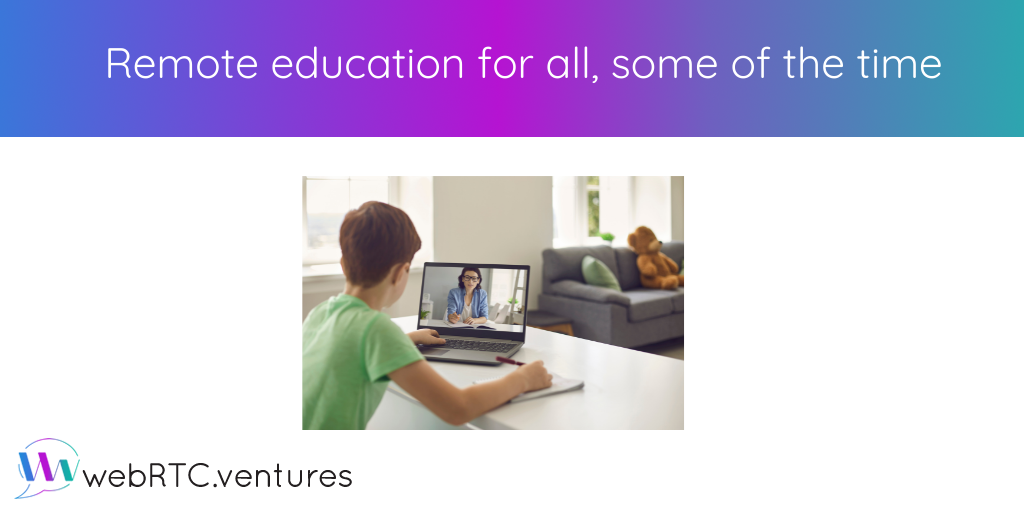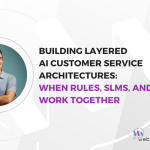As much as I love technologies like WebRTC that enable us to build real-time communication into any browser-based application, the technological magic of adding live video to a classroom does not automatically make for better education. During the coronavirus pandemic, live video apps were literally a life saver for business and also for many personal relationships. But was it the same for education?
In the early stages of the pandemic, we faced tremendous unknowns about how to protect ourselves from COVID and we did not have vaccines or reliable medicine to treat it. Drastic measures were called for, including closing down schools and moving to remote learning. Full-time virtual school during the pandemic was an unequivocal failure for many students. There is no doubt about that.
But is there a place for remote education for all, some of the time?
How the pandemic damaged learning
A recent piece on NPR’s “All Things Considered” highlighted “6 things we’ve learned about how the pandemic disrupted learning.” Here’s the quick headlines of what they covered as failures of remote learning during the pandemic, with additional amateur commentary by myself in parentheses. I do recommend reading the entire article!
- Students learned less when they were remote (some of this was considered a hangover from the first month of the pandemic when most schools closed entirely, and some was attributed to lack of training and experience with how to do remote learning)
- Students at high-poverty schools were hit hardest (sadly it’s no surprise that schools that were already struggling would also struggle even more remotely)
- Different states saw different gaps (the researchers noted states with the most remote education had the largest learning gaps)
- High school graduation rates didn’t change much (due to relaxed standards according to the researchers)
- Many high school grads chose to delay college (as a parent of a recent high school graduate, I can relate. Our son chose to start college but we discussed the benefits of delaying a year if the pandemic had not been improving at that point)
- Schools can do something about it (the researchers discuss things schools are doing like high-dosage tutoring programs to try and help students catch up)
I’m a technologist who works with live video applications, not an expert on education. So I do not doubt any of the findings presented in the article, or the struggles that many have faced.
As a parent, I can relate to some of them. Certainly, my sons both experienced some learning loss due to the pandemic. We were fortunate to be in a well-funded school and they are both already smart kids who were soon to graduate anyways. In other words, they will be fine. The timing of the pandemic and our personal situation meant that our family did not suffer greatly, even if it has been a time of extreme stress and anxiety about both health and education.
Other families and school systems undoubtedly suffer more. Especially those families with younger children or in a more disadvantaged economic situation.
Was this the fault of the pandemic or of remote learning? Or was it simply a matter of how the pandemic was thrust upon us globally without warning, and teachers and schools were (understandably) not well prepared for it? It’s likely safe to say that the pandemic and remote education highlighted problems and inequities which already existed in our education system.
An analogy from software development
This reminds me of something I’ve often said about agile software development methods (which we follow in building live video applications here at WebRTC.ventures).
When teaching people about agile, I’ve often said, “agile methods are not a silver bullet.” They won’t automatically fix the problems in your team. They will, however, shine light on those problems so you can deal with them.
In traditional software development, problems can often be swept under the rug and ignored for a while. We can say things like, “oh, we’ll deal with that during the testing and integration phase, let’s not worry about it right now.” But when you follow agile methodologies like Scrum or Kanban, you are forced to work in smaller increments and do your testing sooner. This doesn’t automatically make your software better, nor does it automatically make your teams communicate effectively. But it does force you to recognize and deal with problems sooner in the software development life cycle.
The tech was ready for the pandemic, but society was not
Something similar can be said about remote education: The technology was ready for the pandemic; the educational system and our culture overall was not. The pandemic and remote education did not necessarily create these problems that the NPR piece discusses. However, the stresses of the pandemic certainly exacerbated and amplified at least some of those problems.
For us as technologists in the live video space, we take tremendous pride in having been “ready” for the pandemic. I don’t mean to be light-hearted about the costs of these past few years. I lost one grandparent in the early days and I’ve lost other family relationships due to the stresses of the pandemic. These have been hard times for everyone in one way or another.
I also don’t mean to say that we saw the pandemic coming in any way, because we certainly did not. What those of us who have worked with WebRTC technologies for many years did see was the potential growth in remote work, online education, telehealth, and many other use cases. We’ve been blogging about these topics on this site since at least 2016.
The technology of online education was ready for the pandemic. Remote meeting tools had already become well established and tested at scale. Some tools have benefited from the pandemic more than others, most notably Zoom. But many companies had already been improving the technology and trying it out in large-scale scenarios long before the pandemic.
None of us were ready for it to experience such exponential growth in such a short time. In July 2020 on our interview series, WebRTC Live, I had Varun Singh as a guest to talk about the incredible growth in video that happened early in the pandemic.
How SHOULD we use live video technology in education?
I believe that technology is inherently neutral. How we as humans wield that technology determines if it’s good or bad. In this case, the technologies behind remote education and remote work were “ready” in the sense that they scaled well (with work!) and society did not collapse when we had to start working from home. This was good on a base level. It was necessary for public health that education allow for more remote options. Learning losses would have been even worse if WebRTC had not existed. But that did not equate to a good experience for everyone.
Now that we are through the worst of the pandemic, should we continue to allow for remote education options? If you look at the negatives described above, you will be tempted to say “no.”
I respectfully disagree. I believe that the pandemic has taught us that we should not try to make all education remote. There is a benefit to being in class, in person, for so many reasons. It should remain the dominant modality for learning.
But just because remote education is not for everyone, and not for every time, doesn’t mean that it’s not right for some people, some of the time.
Where we should apply remote education
Here are a few areas where remote education is still beneficial, and where the pandemic has helped show this benefit:
- Tutoring – We were blogging about the benefits of tutoring online long before the pandemic. My Spanish has been improved greatly by working with a teacher from Ecuador online for many years before I ever met her in person. K-12 students can also benefit from getting access to tutors online so that they can improve in difficult subjects from home, without having to stay at school longer or make their parents travel with them in the evenings.
- Executive Education – Based on the Instagram ads I get, there are blockchain master’s degrees available at every prominent US university. The experience you get with an online continuing education program may not be the same as studying on campus, but for many working adults and parents, it’s just not an option to quit your job and travel to another city for full-time grad school. Online executive education is a very worthwhile option to consider.
- Specialists – Many schools provide on-site specialists for students, whether it’s for someone with a very specific learning disability, or just to provide a unique educational class (like the video game design class one of my sons takes through his high school). Offering these specialists on site is valuable and should always be the top preference, but it’s also expensive for schools, especially for something that a very limited number of students may need. Offering “hybrid” options is worth considering too, where the student has in-person classes most of the day and able to use a computer to connect with a remote specialist for part of the day for those more unique needs which the school cannot provide on-campus.
- Regional Support – For students at a very high poverty school or very remote rural school, schools may struggle to provide the full scope of educational options on campus that they desire. Here again, a hybrid option can be helpful, where some remote instructors can work with students at multiple schools on very niche subjects that each school may not be able to provide efficiently on their own.
- Backup option – Remote education should remain simply as a backup option, regardless of public health. Individual health concerns may still cause a student to be home for extended periods of time, and just sending home worksheets like my schools did in the 1980’s won’t cut it. We should continue to offer the option for students to join a class remotely.
In order to be effective, we should not assume that the current technology is good enough. While the basics of WebRTC are ready for prime-time, as the pandemic has shown, that does not mean we should all use Zoom for any remote education needs. Additional measures need to be considered based on the specific use case:
- Strong User Experience Design – Not just any video chat tool will do for many situations, and poorly designed user experiences account for many problems that students encounter in remote learning.
- Specialized Training – As noted in the NPR article, teachers were not given any training at the beginning of the pandemic. Now that we know remote learning is part of the future (even if it’s not the entire educational experience), educators should be given more training on best practices in online learning. We should not assume that this will never happen again.
- Technology Support – Consider how common it is in corporate offices (remember those?) to have meeting rooms with fully equipped conference call and video conferencing equipment. In order to support hybrid classrooms and remote learning for sick students, schools will also need to continue to invest in strong technology support. The easier that we can make it for a teacher to flip on a camera and then go about their normal teaching style, the better remote learning will become.
Remote education for all, some of the time
Consider how the pandemic has changed healthcare. There are many parallels to draw with online education.
Because of the upheaval caused by the pandemic and the relaxation of HIPAA regulations around telehealth, I no longer have to see my doctors in their office. When I recently had COVID, I was able to have a telehealth visit with my doctor, get a prescription, and be treated without ever burdening my area hospital or putting my doctors’ other patients at risk by visiting their office. That is a very good thing! I was able to get the care I needed to make a quick recovery without leaving my house and putting anyone else at risk.
While this is an example of a telehealth success causing a revolution in healthcare, it doesn’t mean that we will move all healthcare to video chat.
The same is true in education. The pandemic has shown us that widespread remote education did not work well. If we have to do it again in the future for public health reasons, hopefully it will work better because schools are better prepared and teachers have at least experiential training with remote learning. Our goal should never be to go back to fully remote learning for everyone, all the time.
The use cases described above, and many more, show that remote learning can be truly revolutionary. We should be not only encouraging these avenues, but also supporting it with improved technology experiences and better software design. There is still a lot of room for the application of WebRTC technology to improve online education.
If you need help designing, building, and testing your online education application – we can help! Contact our experts at WebRTC.ventures today.











